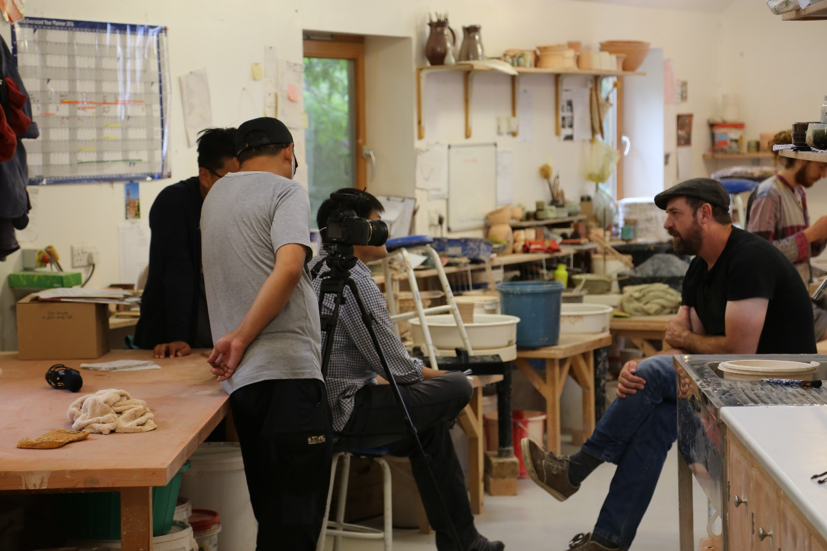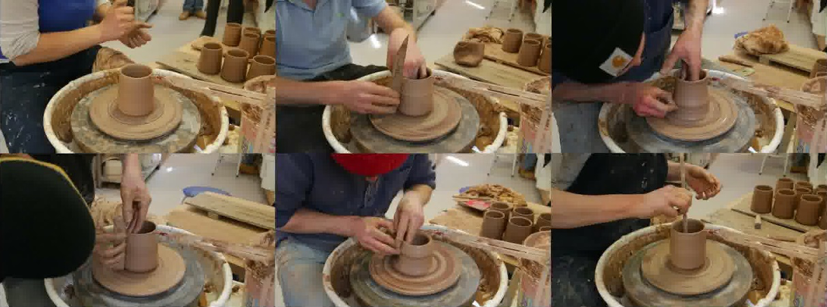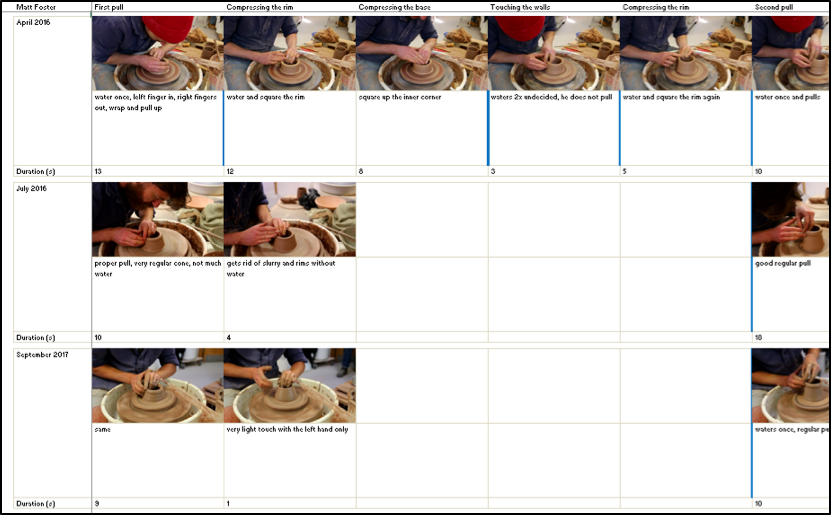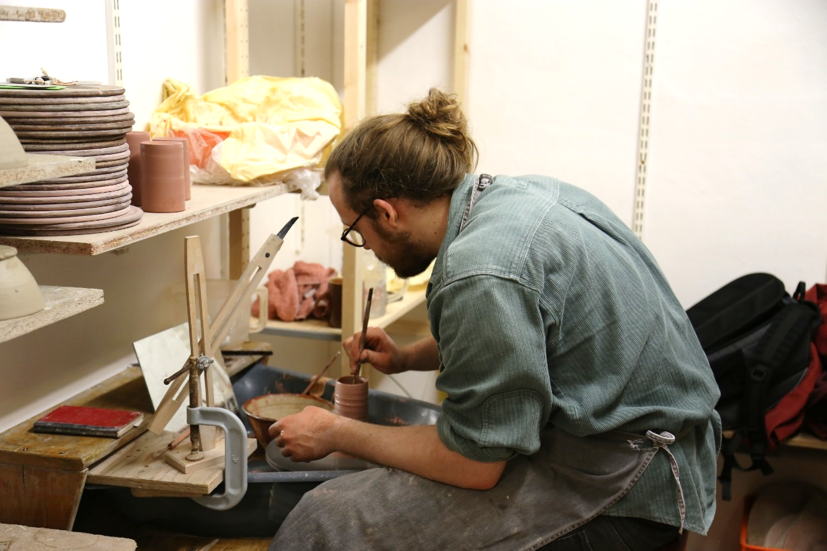
Giorgio Salani
This article discusses the use of video in helping aspiring potters develop their skills at the potter’s wheel. It summarises findings from the author’s doctoral research on British pottery practices, which made effective use of videos to record operations and elicit tacit knowledge involved in making pottery. Many potters are familiar with video tutorials and use videos to promote their work commercially. Showing potters their actions at the wheel can help them map their progress and identify issues to overcome. The study proposes the use of video as a reflective tool for aspiring potters, to advance their progress more efficiently in professional and other learning environments.
reflection; video; ceramic training; throwing; pottery; Ceramic Design
The use of videos for capturing data on making processes (Gowlland, 2015; Harper, 2013; Lehman, 2012) and for representing embodied and multisensory experiences (Pink, 2013) is well-established in craft studies. Anthropologist of craft, Geoffrey Gowlland utilised videos to reveal the visible and ‘“invisible” dimensions of skilled ceramic practice’ (2015, p.286). For Paul Harper filming ‘is particularly suited to investigating embodied experience; it shows the subjects in a context and shows them interacting with that context; the complexity of thinking in action can be observed’ (2013, p.7). In her research on taxonomic craft, Merle Patchett uses video ethnography and has noted how videos can emphasise ‘the serious empirical involvements required of researchers when engaging with the practices, embodiments and materialities of craftwork’ (2015, p.3). Finally, for Sara Pink videos can play a key role in enabling reflexivity in ethnographic fieldwork (2013, p.107), one of the research methods used in the doctoral study which informed this article (Salani, 2018).
Today, a vast number of online videos and DVD tutorials are available to ceramic practitioners and researchers. These include professional archives such as the National Electronic and Video Archive of the Crafts (NEVAC) in Bristol (Guyatt, 2000) and the British Library Sounds collection. My recent doctoral research on the making of contemporary British tableware pottery suggests that many UK practitioners are familiar with videos of potters at work (Salani, 2018). Through interviews, research and practice-based experiment the study explored the origin of physical qualities of hand-thrown tableware in the sequence of operations required for its production, and meanings and interpretations associated with pots, potters and their processes. Interviews with 13 professional potters outlined they all had watched video tutorials and many had made videos to promote their work on social media. The most renowned potters had also participated in television interviews and documentaries, as in the case of master potter Roelof Uys being interviewed by a Korean TV crew during fieldwork conducted for the study (see Figure 1).

Despite the effectiveness of video when capturing and communicating craft knowledge, and the familiarity of this medium amongst potters, videos are not commonly used in formal ceramic training in the UK. This article suggests that an integrated studio practice that uses video to record procedures and track progress will benefit pottery making as well as learning in this field. More specifically, it discusses the use of video as an analytical and reflective tool to advance ceramic training in professional learning environments.
This research, exploring the applications of video in pottery making, involved fieldwork, conducted at three established British workshops. This fieldwork formed the basis of a doctoral degree at the University of the Arts London (Salani, 2018). This approach analysed contemporary methods of making tableware on the potter’s wheel. Due to the size of the team and its educational mission, the Leach Pottery in St. Ives, Cornwall, provided an ideal environment for the study of skill development and transmission. Information was gathered using photos, videos, observation and extensive responsive interviews with each of the seven potters working there. Furthermore, 5 weeks of work experience at the pottery (conducted between April and July 2016) enabled me to practise making their standard range of mugs, gaining insight into these processes.
An intimate knowledge of the potters’ approaches along with their awareness that I was a maker as well as a researcher, enabled access, providing the opportunity to record their making operations. This was done through videos, practical tests in a variety of techniques through studio practice and by gathering feedback from the potters. Despite the fact that video only captures a fraction of what happens on site (Emerson, Fretz and Shaw, 2015, p.9), the medium is ideally suited to capturing making procedures (Harper, 2013; Patchett, 2014). This particularly applies to complex phases in making practice which often occur over a short period of time, such as the preparation of clay, throwing at the wheel, attaching a handle, ‘turning’ the pots (shaving off excess clay with a sharp tool) and decorating them with glaze.
The study followed a ‘naturalistic’ approach (Denzin and Lincoln, 2008). Most videos captured actions in the making, as they occurred in the workshop. More fixed settings were used to produce a smaller number of videos of processes to enable direct comparisons, e.g. across potters performing the same task. This followed David MacDougall’s concept of ‘constructive camera’ by which the subject is broken down and reassembled to provide further insights (2006, p.4).
During the first on-site visit to the Leach Pottery in April 2016, six potters were filmed (with their written permission). Each was recorded throwing a mug cylinder one after the other on the same potter’s wheel. The same camera view was used to film the potters, shot in quick succession over the same afternoon and under similar light conditions. Using a clock face metaphor, the camera was placed at a 7 o’clock position, with the potter’s wheel at 12 o’clock. The camera viewpoint was raised from the wheel-head to clearly show hands and tools in action. Clips were then synchronised and shown side-by-side in a split-screen video collage (see Figure 2). Harper suggests showing videos back to participants to elicit further insights into making processes (2013, p.172). When I played the collage back to the team, the potters discussed differences and immediately identified areas for improvement.

In another video collage, I recorded Leach potter Matt Foster throwing the same mug design at different stages in his apprenticeship. In April 2016, Foster could throw the correct shape but had limited experience at the wheel. By my second visit in July, he had thrown hundreds of mug cylinders and was ready to show his progress on-camera. When I visited the pottery again in September 2017, I filmed him throwing the same mug design once again.

A comparison of these clips shows substantial differences in Foster’s approach to making the same product (Salani, 2017; Figure 3). Between my first two visits, the time it took him to throw the shape had almost halved from about 5 minutes to less than 2.5 minutes, which is a time very close to a proficient performance (i.e. about 2 minutes).
Comparative analysis of the videos involved creating a ‘process matrix’, which showed the duration of each making-operation (Figure 4). Time savings were mostly attributable to Foster learning to skip unnecessary movements or operations (about 2 minutes) as opposed to his performing these operations more quickly (about 30 seconds). In only 3 months, Foster reduced the number of total technical operations from 36 to 21. Excessive use of water is a typical sign of inexperience, and he used water 9 times in the final video compared with 20 times during the initial recording.

The differences between July 2016 and September 2017 were more nuanced. The use of water and the total number of operations remained largely the same. By September 2017, Foster could throw a mug cylinder in less than 2 minutes; however, he was still following a similar procedure to that used over a year earlier. He learned how to perform the operations slightly faster, and there were subtle improvements to the visual and tactile qualities of his mugs.
Ann-Sophie Lehman observes that both still and moving images are ‘extremely useful in the analysis of making’ (2012, p.9). They can perform archival, instructional, participatory and display functions. This multi-functionality, along with availability and an increasing familiarity with these technologies (especially among younger generations of students) makes them an ideal tool to assist the learning of pottery.
As discussed in interviews, Foster found the videos of his throwing techniques helpful. They helped him understand what he was doing wrong and promptly correct his methods (Foster, 2016). Similar comments were made by Britta Wengeler-James, a more experienced member of staff (Leach Pottery, 2016). This suggests that video comparisons facilitate the learning and continued development of pottery skills, and could be used as part of a structured learning path for students as well as more experienced practising potters.
Some potters use mirrors to check the shape from another viewpoint without having to move away from the throwing posture, which can take up valuable time during a fast process (Figure 5). As well as enhancing reflection on methods, the potter’s actions are observed at the same time as making. Echoing Donald Schön’s terminology, mirrors facilitate ‘reflection in action’, whilst videos can be used for ‘reflection on action’ (1983).

The comments captured as part of this study suggest that video can enable ‘reflective observation’ and ‘abstract conceptualisation’ (Kolb, 1984). Self-reflection, or reflexive thinking, through video analysis does not provide a shortcut that lessens the need for practice, as new understanding is always tested through ‘active experimentation’ and ‘concrete experience’ (ibid). In interviews, the potters explain their progress as ‘learning by doing’ (Wengeler-James and Wheeler, 2016), and are aware that the repetition of the same actions over many iterations is always necessary in order to acquire and develop the craft skills they desire.
The tacit knowledge (Polanyi, 1966) involved in making pottery and other crafts can constitute a ‘troublesome knowledge’ that prevents students from progressing (Meyer and Land, 2006, p.12). Knowledge of pottery making may remain implicit within a practitioner’s techniques. Video comparisons can provide an additional form of engagement with making processes, guiding students beyond the required ‘knowledge threshold’ and opening up new ways of understanding (ibid, p.3). By watching themselves make in videos and reflecting on their methods, recordings can help aspiring potters at moments when they feel ‘stuck’, are struggling or do not know how to proceed in mastering certain skills.
Making tutorials and videos by the potters available, enables the information recorded to be shared in group and peer-to-peer learning, as in the case of the Leach Pottery. Jenny Moon suggests that sharing reflection with others (in this example, watching videos together) can enhance reflection and peer review (cited in McDonnell, Lloyd and Valkenburg, 2004, p.516).
Instructions from tutorials only typically describe proficient methods of making. Instead, video can be used to monitor progress and set intermediate and individual goals for students at all levels of learning. Based on the example of Matt Foster described above, after the initial goal of matching a design is met, incremental steps can be taken to reduce the number of actions required to make a pot, reduce the amount of water needed to lubricate the clay and, gradually, speed up the process. Intermediate exercises can be tailored to individual students to guide them in their learning path.
The article has described how the technique of ‘direct video comparison’ is effective in analysing pottery making. Recordings of making enable processes to be seen by the maker and for these approaches to be shared with others, allowing the identification of skill levels and differences between potters, and enabling makers to continue to develop these skills over time. Established and aspiring potters can use video as an effective tool to reflect on their progress and correct actions. This method can be applied effectively to a structured learning environment such as the professional workshop described here, the Leach Pottery, where personal reflection could be further enhanced by direct feedback from senior potters.
This approach could likewise be adapted and used on a formal ceramic course at university and technical school levels. Videos can be used by students to measure and reflect on their skill levels, and by teachers to formally assess the students’ progress. For self-learners with limited access to one-on-one tutorial sessions, or distance learners with less contact, the reflexive use of videos could play an even more crucial role in assessing skill levels and identifying solutions. Video tutorials can address specific issues and suggest tailored exercises to develop craft knowledge and skills to the next level.
Denzin, N.K. and Lincoln, Y.S. (eds.) (2008) Collecting and interpreting qualitative materials. 3rd edn. Thousand Oaks, Calif: SAGE.
Emerson, R.M., Fretz, R.I. and Shaw, L.L. (2011) Writing ethnographic fieldnotes. 2nd edn. University of Chicago Press, Chicago.
Foster, M. (2016) Interviewed by Giorgio Salani, 28 and 30 July. Unpublished interview.
Gowlland, G. (2015) ‘Unpacking craft skills: What can images reveal about the embodied experience of craft?’, Visual Anthropology, 28(4), pp.286–297. https://doi.org/10.1080/08949468.2015.1052324.
Guyatt, M. (2000) ‘The national electronic and video archive of the crafts (NEVAC)’, Journal of Design History, 13(2), pp.151–159. https://doi.org/10.1093/jdh/13.2.151.
Harper, P.W.H. (2013) Doing and talking: The value of video interviewing for researching and theorizing craft. PhD thesis. London Metropolitan University.
Leach Pottery (2016) Interview with Kat Wheeler, Matt Foster, Callum Trudgeon and Britta Wengeler-James by Giorgio Salani, 22 April. Unpublished interview.
Lehman, A-S. (2012) ‘Showing making: On visual documentation and creative practice’, The Journal of Modern Craft, 5(1), pp. 9–24. https://doi.org/10.2752/174967812X13287914145398.
Kolb, D.A. (1984) Experiential learning: Experience as the source of learning and development. Englewood Cliffs, N.J: Prentice Hall.
MacDougall, D. (2006) The corporeal image: Film, ethnography, and the senses. Princeton N.J.: Princeton University Press.
McDonnell, J., Lloyd, P. and Valkenburg, R.C. (2004) ‘Developing design expertise through the construction of video stories’, Design Studies, 25(5), pp.509-525. https://doi.org/10.1016/j.destud.2004.05.005.
Meyer, J.H.F. and Land, R. (2006) Overcoming barriers to student understanding: Threshold concepts and troublesome knowledge. London: Routledge.
Patchett, M.M. (2015) ‘Witnessing craft: Employing video ethnography to attend to the more-than-human craft practices of taxidermy’ in Bates, C. (ed.) Video methods: social science research in motion. London: Routledge, pp.71–94.
Pink, S. (2013) Doing visual ethnography. London: SAGE.
Polanyi, M. (1966) The tacit dimension. Garden City, N.Y.: Doubleday and Company Inc.
Salani, G. (2016) Leach potters throwing a standard ware mug. Available at: https://vimeo.com/221414932 (Accessed: 10 August 2018).
Salani, G. (2018) Salience, qualities and narratives in the making of contemporary British hand-thrown tableware. PhD thesis. University of the Arts London.
Schön, D.A. (1983) The reflective practitioner: How professionals think in action. New York: Basic Books.
Wengeler-James, B. (2016) Interviewed by Giorgio Salani, 26 April. Unpublished interview.
Wengeler-James, B. and Wheeler, K. (2016) Interviewed by Giorgio Salani, 30 July. Unpublished interview.
Giorgio Salani is a ceramic maker and doctoral researcher specialising in the intersection between traditional crafts and design. His focus on materials, methods and technologies derives from his engineering background and consulting experience. Giorgio’s practice-led PhD research identifies and discusses key physical qualities and narratives associated with British hand-thrown tableware pottery, and locates their origins in the sequence of operations involved in the production of the ware.